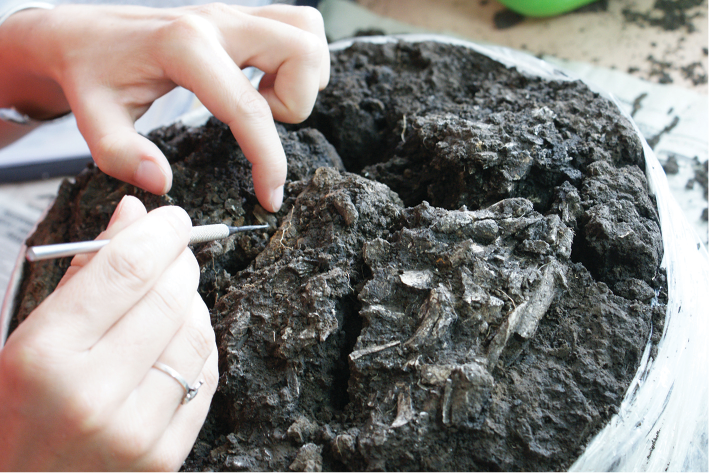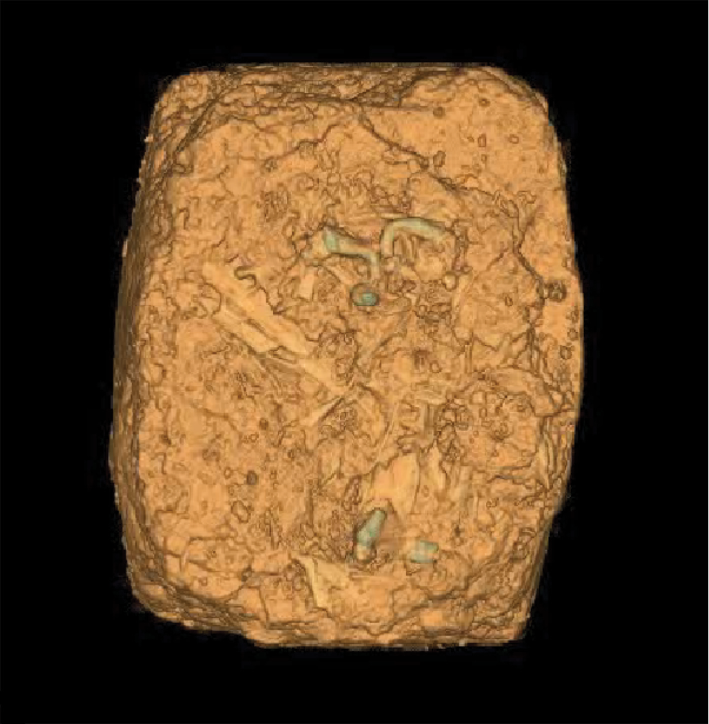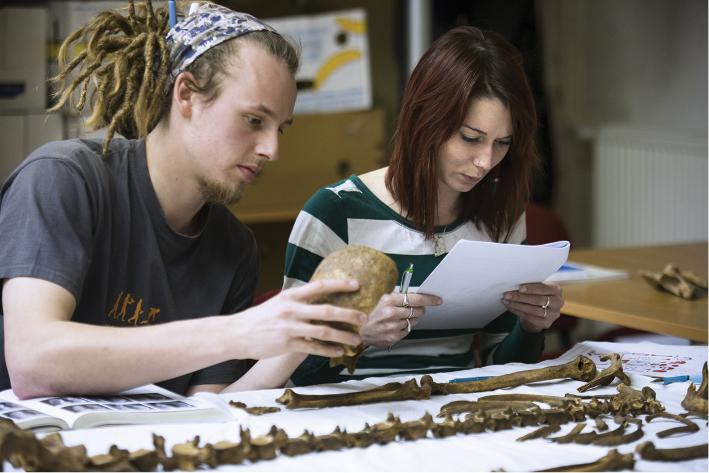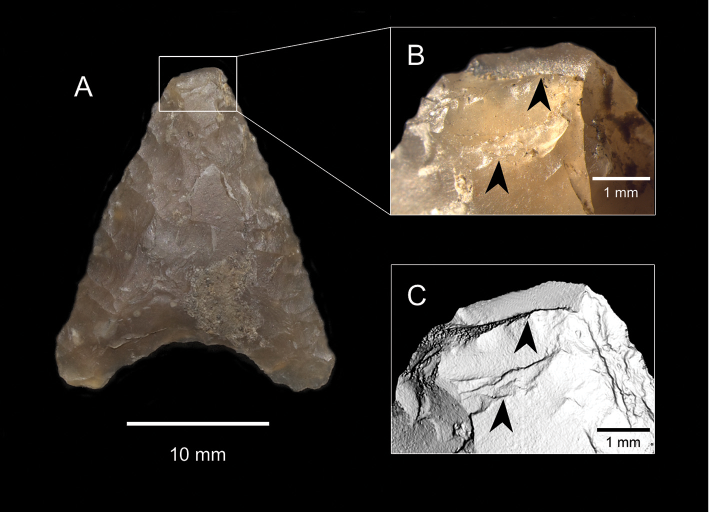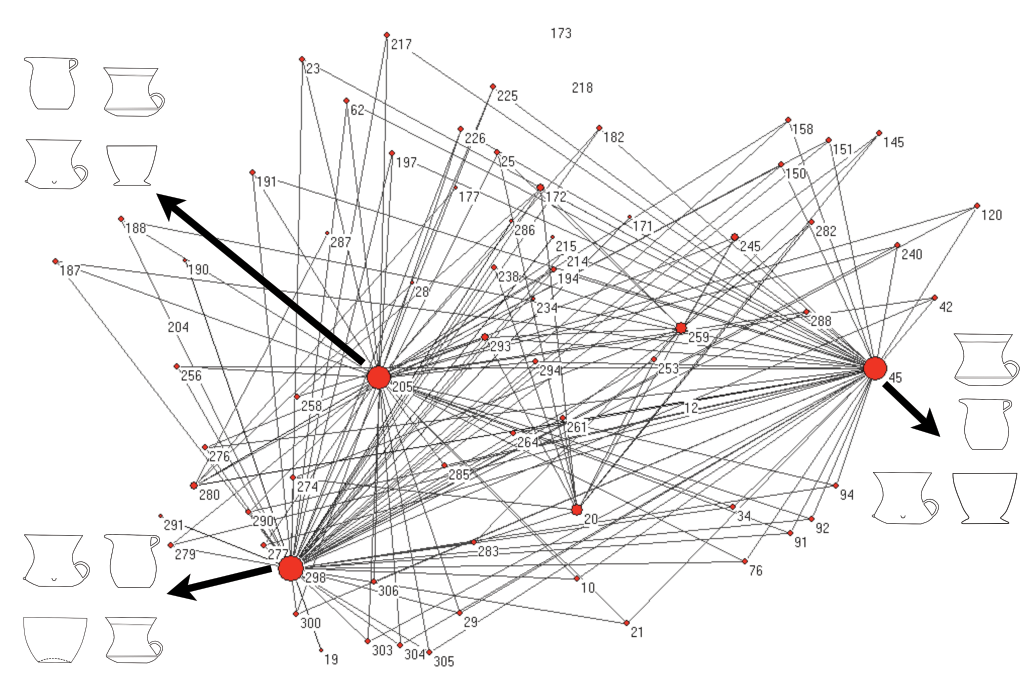
Volume V ● Issue 1/2014 ● Pages 85–89
A look at the region
Biological Anthropology at the Department of Anthropology, University of West Bohemia in Plzeň (www.oba.zcu.cz)
Vladimír Blažeka, Lukáš Friedla, Patrik Galetaa, Anna Pankowskáa*, Daniel Sosnaa
aBiological Anthropology, Department of Anthropology, University of West Bohemia in Plzeň, Sedláčkova 15, 306 14 Plzeň, Czech Republic
Article info
Article history:
Received: 2 July 2014
Accepted: 5 August 2014
Keywords:
anthropology
osteology
funerary analyses
locomotory patterns
palaeodemography
human behaviour and variation
microscopic analyses
Abstract
Biological Anthropology of the Department of Anthropology at University of West Bohemia in Plzeň was established in the year 2000. The purpose of this step was to broaden the range of courses which relate to the biological basis of human behaviour. This resulted in the accreditation of the master’s degree programme Anthropology of Past Populations. Anthropology of Past Populations aims at training future specialists in bioarchaeology. Graduates of the programme are taught to use all the information which is available from the human skeletal remains along with all the information from related fields of archaeology and comparative ethnology to build an image of past human societies. The research activities of the individual members closely linked to the overall aims of the Division of Biological Anthropology. They all have a common denominator, this being a retrospective and evolutionary approach to the study of past human societies.
1. Introduction and an overview of the educational aims
The Division of Biological Anthropology under the authority of the Department of Anthropology at the University of West Bohemia was established as a centre providing biologically oriented courses to students of social and cultural anthropology. This idea was originally born shortly prior to the year 2000 in discussions between Ivo Budil and Jaroslav Slípka concerning the future prospects of the newly emerging Faculty of Humanities, currently the Faculty of Philosophy and Arts at the University of West Bohemia. The founding fathers of the division were Jaroslav Kos, Jaroslav Slípka, and Evžen Strouhal. All of them were renowned figures in Czech and international medical and anthropological circles: Jaroslav Kos in anatomy, Jaroslav Slípka in evolutionary embryology and histology and Evžen Strouhal in historical anthropology, paleopathology and mummy studies. Despite their unequivocal importance for the establishment of the division, their contribution was, from the very beginning, limited by the fact that they all had already retired and therefore, a certain generational turnover was inevitable.
Vladimír Blažek enriched the team in the year 2000. The primary purpose of this step was to broaden the spectrum of courses the division could offer, mainly for subfields that relate to the biological basis of human behaviour, namely, nonverbal communication, sociobiology, and human ethology. Vladimír Blažek consequently overtook the greatest portion of the biologically focused anthropology courses and also became the first formal chair of the division. Jaroslav Brůžek also became involved in the educational and research activities of the division. Although he never fully affiliated himself with the department due to his primary occupation at the University of Bordeaux I, he played an extremely important role in the subsequent development of the division. Jaroslav Brůžek and Vladimír Blažek helped to negotiate the acceptance of additional younger colleagues into the department. As a result, Vladimír Sládek, Patrik Galeta and Daniel Sosna have been employed as members of the department, although their contribution to the division’s biologically driven activities has not been equal, with Daniel Sosna always being the “connecting bridge” between the biologically and culturally oriented faculty members. Over that same time period, two major shifts in the educational aims occurred, both of which structured the future educational and personal status of the division within the department and the faculty.
First, several new courses have been accredited, all together providing a further spectrum of biologically oriented courses to students of social and cultural anthropology, sociology and other humanities-based study programmes. These courses included Neuroanatomy and Psychobiology, Development of Cognition and Behaviour, Introduction to Behavioural Sciences, Demography, Human Variation and Adaptation, and also Statistics for Social Sciences.
The second and much more important step forward was the successful accreditation of the master’s degree programme Anthropology of Past Populations for which the idea and majority of preparation work came from Vladimír Sládek. This new programme further helped strengthen the division’s position within the Faculty of Philosophy and Arts but also helped to provide room for research and educational growth in the division’s personnel, as well as for linking with additional Czech, European and American institutions. In terms of science, it provided an excellent opportunity to transfer from anthropometry and race based European physical anthropology to the fully integrated, problem oriented and hypothesis driven biological anthropology practiced in the western world. The Anthropology of Past Populations aims at training future specialists in bioarchaeology and funerary anthropology. Graduates of the programme are taught to use all the information which is available from human skeletal remains along with all the information from related fields of archaeology and comparative ethnology to build an integrated, interdisciplinary image of past human societies. Apart from these formative skills, our students are presented with evolutionary understandings of the biological oneness of humans with its relation to social and cultural spheres represented by artefacts, as well as with other traces of our ancestors in the past. The emphasis is placed on a detailed knowledge of the human skeleton and methods of its study in bioarchaeology. This is facilitated through fieldwork which takes place every year at a medieval church cemetery at the Church of the Holy Spirit in Všeruby under the auspices of Vladimír Sládek and the archaeologist Martin Čechura. A no less significant aspect of the programme is the raising of awareness about the significance of natural and cultural heritage and its reflection in contemporary society.
The Division of Biological Anthropology underwent significant reform over the last five years. Vladimír Sládek accepted a chair position at the Department of Anthropology and Human Genetics at Charles University in Prague in 2008 and although he continues to collaborate with the division, his move to Prague resulted in the necessity to hire a new faculty member who would take over the courses originally taught by him. Vladimír Sládek’s position was offered to Lukáš Friedl who is one of the first graduates of the Anthropology of Past Populations programme. There was recently also a new addition when Anna Pankowská joined the team. The division’s position is currently stabilized. It is also quite unique within Czech universities because it is a biologically focused unit within an otherwise fully humanities-based school.
2. Research activities
The research activities of the individual members are closely linked to the overall aims of the Division of Biological Anthropology. They might seem rather diverse but they all have a common denominator, which is a retrospective and evolutionary approach to the study of past human societies through studying human biological variation and its relationship to social and behavioural variables.
2.1 Funerary analysis
Funerary analysis stands as one of the topics in which all the members have been, at some point, involved in to a greater or lesser degree. Through an analysis of prehistoric burial sites, we repeatedly demonstrate the potential that these types of research activities can offer, particularly through a combination of bioarchaeological, archaeological and ethnographic approaches. We use innovative statistical procedures and place our results into the framework of social theories in the way that our interpretations articulate ideas of social differentiation and the dynamics of past societies. Funerary analysis also involves an understanding of the transformation processes which form archaeological material and methods of analysis of skeletal and cremated burials.
Analysis of cremated burials potentially provides a great deal of information about the funerary practices of past societies. The amount and quality of data depends, however, on how detailed the analysis is and on what methods are used during the procedure. Since cremations are extremely fragile and are easily reduced through manipulation, there is a need to incorporate very careful and generally more demanding procedures, such as micro-excavation along with imaging through computed tomography. Micro-excavation generally helps to reduce fragmentation, increase the fragment identification rate, allows for documenting fragments space relations and by doing so enhances our ability to interpret the funerary behaviour of past societies. Furthermore, the manner in which the space relation data are gathered allows us to use GIS systems and construct 3D models on which we can test hypotheses concerning the spatial relationships within a single cremation.
2.2 Robusticity and locomotion in human evolution
We also continue to analyse the locomotory patterns of past populations through studies of cortical bone distribution within the lower limb long bones. We aim at improving currently used methods for reconstruction of mechanical loadings and locomotory patterns of past societies. There are also research activities which focus on the reconstruction of human evolutionary history. We specifically work with topics related to human body proportions and their evolutionary, historical, and ecological determination, as well as with topics concerning the emergence of anatomically modern humans and their relation to other archaic populations or species (e.g. Neanderthals). The Division of Biological Anthropology also participates in a field project on the Palaeolithic cave site of Lapa do Picareiro (central Portugal) where we focus on the nature of the transition between Neanderthals and early modern humans. This field project is also important because we collaborate there with several colleagues from American and Portuguese institutions and also serves as one of the two fieldworks we offer to our students.
2.3 Palaeodemography
Another research area focuses on the methodology of demographic parameters estimation. This area is one of the most traditional topics in bioarchaeology. A portion of our work includes research into current statistical and demographic procedures for their use in age, sex and stature estimation. We also develop demographic models allowing us to describe the population trajectories of past societies even when there is a lack of skeletal material. We recently tested the reliability of sex estimates based on handprints left in Palaeolithic caves.
2.4 Microscopic analyses
When currently broadening the spectrum of activities in our Laboratory of Biological Anthropology, we are developing procedures to use stereoscopic microscopes for the study of past human behaviours. We aim at two primary areas of research. The first one is microscopic use wear analysis of stone arrowheads. Through experimentation and use wear analyses, we attempt to understand what the role of weapons in certain prehistoric societies was like. The second area is a microscopic study of human skeletal remains, specifically dentition and bone fragments. Some of the questions we aim at are related to nutrition, the operation of taphonomic agents, and the relationship between ontogeny and phylogeny. We use microscopic analysis, for example, to differentiate early stages of enamel pathogenesis in which it is extremely difficult to separate biogenic and diagenetic processes on the macroscopic level. Another use is for an analysis of burnt and unburnt bone surfaces with the ultimate aim of differentiating between natural and cultural modification.
2.5 Human behaviour and cognition
One of the interdisciplinary research directions which we follow is the study of the biological foundations of human behaviour and cognition in the context of the human brain’s functional evolution. The primary topic in this direction is the perception of facial features and the recognition of sexually dimorphic characteristics which relate to personal qualities and mate choice. Mate choice is not only influenced by the level of masculinity or femininity but also by face symmetry and self-similarity. Our interest in the human face is also linked to bonding schemes between mothers and their offspring and also lastly to the perception of inter-population differences which structure xenophobic and racist attitudes. Our research not only focuses on the documentation of face variation, but also attempts to pinpoint the evolutionary based meanings we attribute to our faces, primarily because these meanings have a rather complex origin through various forces (e.g. sexual selection).
3. Overview of the taught courses
An overview of the courses can be found at: www.oba.zcu.cz
Acknowledgement
The publication was supported by the Motivational system of the University of West Bohemia in Plzen, section POSTDOC.
Selected literature
BLAŽEK, V. 2011: From “race” to ethnocentrism and back. (Od „rasy“ k etnocentrismu a zpět – in Czech). Acta FF 2011(3), 59–83.
BLAŽEK, V., BRŮŽEK, J. 2012: Anthropology of the sleeping activity or else anthropology of sleep. (Antropologie o spánku aneb antropologie spánku). Slovenská antropológia 15(1), 1–4.
BLAŽEK, V., BRŮŽEK, J., CASANOVA, M. F. 2011: Plausible mechanisms for brain structural and size changes in human evolution. Collegium Antropologicum 35(3), 949–955.
BLAŽEK, V., HOŠKOVÁ, M., URBÁNKOVÁ, T., SEDLÁKOVÁ, Ž. 2010: Sex recognition on face and question of sexual dimorphism. (Rozpoznávání pohlaví podle obličeje a otázka sexuálního dimorfismu). Slovenská antropológia 13(1), 6–9.
BLAŽEK, V., TRNKA, R., HAVLÍČEK, J., LINDOVÁ, J., PIVOŇKOVÁ, V., RUBEŠOVÁ, A. 2009: Human face: Perception of face in view of cognitive, behavioural and social sciences. (Lidský obličej: Vnímání tváře z pohledu kognitivních, behaviorálních a sociálních věd ). Karolinum, Praha.
FISCHER, M.D., LYON, S.M., SOSNA, D., HENIG, D. 2013: Harmonizing Diversity: Tuning Anthropological Research to Complexity. Social Science Computer Review 31(1), 3–15.
FRIEDL, L. 2011: Confounding factors in interpreting fracture frequencies in skeletal populations. Antropowebzin 2/2011, 91–96.
GALETA, P. 2010: Odhady ukazatelů porodnosti a přirozeného přírůstku v paleodemografii. Demografie 52, 77–89.
GALETA, P., BRUZEK, J. 2009: Demographic model of the Neolithic transition in Central Europe. Documenta Praehistorica 36, 139–150.
GALETA, P., BRUZEK, J., LÁZNIČKOVÁ-GALETOVÁ, M. 2014: Is sex estimation from handprints in prehistoric cave art reliable? A view from biological and forensic anthropology. Journal of Archaeological Science, doi: 10.1016/j.jas.2014.1001.1028.
GALETA, P., SLADEK, V., SOSNA, D., BRUZEK, J. 2011. Modeling Neolithic dispersal in Central Europe: demographic implications. American Journal of Physical Anthropology 146, 104–115.
HAVLÍČEK, J., BLAŽEK, V. 2012: What is the relation of human ethology to anthropology? A brief historical account. Anthropologie L, 3–7.
HOLLIDAY, T.W., FRIEDL, L. 2013: Hominoid humeral morphology: 3D morphometric analysis. American Journal of Physical Anthropology 152, 506–515.
KUBÁTOVÁ, I., FRIEDL, L., JURMAN, K., LUNGOVÁ, V, HAWS, J., BENNEDETI, M. 2013: Metodologie výzkumu paleolitické jeskyně Lapa do Picareiro (Portugalsko). Antropowebzin 2/2013, 57–65.
PANKOWSKÁ, A. 2009: Comparison of health status in human skeletal remains disposal in settlements and necropolises in the Early Bronze Age (in Central Moravia, Czech Republic). Anthropologie XLVII/3, 215–228.
PANKOWSKÁ, A., DAŇHEL, M., PEŠKA, J. 2013: Formal classification of settlement burials from Moravia (the Czech Republic) dating from the Early Bronze Age. In: Mueller-Scheessel, N. (Ed.): “Irreguläre“ Bestattungen in der Urgeschichte: Norm, Ritual, Strafe …? Internationale Tagung. Frankfurt am Main. Kolloquien zur Vor- und Frühgeschichte, R. Habelt, Bonn, 251–265.
PANKOWSKÁ, A. GALETA, P., ŠMOLÍKOVÁ, L., ŠNEBERGER, J., JURMAN, K. 2014: Hodnocení shody identifikace lidských stálých zubů v závislosti na jejich zachovalosti. Česká Stomatologie 114 (1), 15–23.
SLÁDEK, V., BERNER, M., GALETA, P, FRIEDL, L., KUDRNOVA, Š. 2010: Technical note: the effect of midshaft location on the error ranges of femoral and tibial cross-sectional parameters. American Journal of Physical Anthropology 141, 325–332.
SLÁDEK, V., GALETA, P., SOSNA, D. 2012: Measuring Human Remains in the Field: Grid Technique, Total Station, or MicroScribe? Forensic Science International 221, 16–22.
SOSNA, D. 2009: Social Differentiation in the Late Copper Age and the Early Bronze Age in South Moravia (Czech Republic). Archaeopress, Oxford.
SOSNA, D., GALETA, P., ŠMEJDA, L., SLÁDEK, V., BRUZEK, J. 2013: Burials and Graphs: Relational Approach to Mortuary Analysis. Social Science Computer Review 31(1), 56–70.
SOSNA, D., SLÁDEK, V., GALETA, P. 2010: Investigating Mortuary Sites: The Search for Synergy. Anthropologie 48(1):33–40.
TŮMA, P., ŠNEBERGER, J., HOŠEK, R., HAWS, J., BENEDETTI, M., FRIEDL, L. 2012: Proměny přístupů studia neandrtálců – s příkladem výzkumů v Portugalsku. Antropowebzin 3/2012, 209–216.
*Corresponding author. E-mail: annapankowska@gmail.com

Figure 1. Network analysis in funerary studies (figure by Daniel Sosna).
Figure 2. Micro-excavation of cremation burials (photo by Erika Průchová).
Figure 3. Using a CT scan for recording cremation burials. CT by Miroslav Heřman from the Radiology Department at the University Hospital in Olomouc.
Figure 4. Robusticity and locomotion of past human populations (figure by Lukáš Friedl).
Figure 5. Students of the master’s degree programme Anthropology of Past Populations (photo by Petra Lupták Burzová).
Figure 6. Microscopic analysis of the stone industry (figure by Daniel Sosna).
